Had another go at processing the Andromeda frames, here's another version:
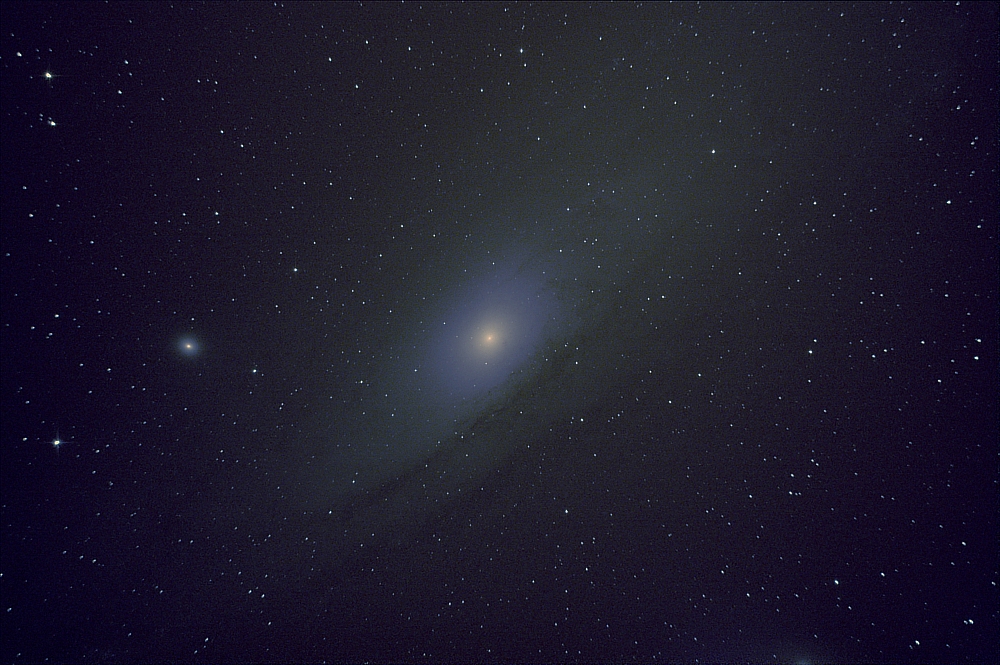
Andromeda Galaxy (M31).
(Nikon D50 at prime-focus on C8-N, ISO 200, no filters, 22 x 30s colour exposures stacked with DSS, reprocessed in PS CS3)
Had another go at processing the Andromeda frames, here's another version:

Andromeda Galaxy (M31).
(Nikon D50 at prime-focus on C8-N, ISO 200, no filters, 22 x 30s colour exposures stacked with DSS, reprocessed in PS CS3)
After what seems to be many weeks of overcast skies, Friday evening was clear enough to get out and test the new focuser setup. After a delayed start due to a mucky secondary mirror, the scope was recollimated and set up in the back yard. I did a few visual checks of random bright stars to confirm that all was OK, then decided that it was time to grab a few images for analysis later.
I slewed the scope around to the faint blur that is the Andromeda Galaxy (Messier 31), then slapped on the D50 for some prime-focus shots. This was to be my first semi-serious foray into taking this sort of shot, and I just wanted to get a few images to stack and play with, nothing too difficult.
Anyway, focusing was a lot better with the new setup. After transferring a few shots from the SD-card to the laptop to confirm image acceptability, I rattled off a series of raw files (NEFs), all at 30s, just to see what could be achieved at such relatively short exposures.
After a quick look around to see a few double-stars, the dreaded dew started to form and it was time to pack away and start photo-processing.
The individual frames didn't seem too bad - focus was just a tad out on the later pics, it looks like there was some minor focus-drift over time. The stars at the corners of the pics are distorted due to coma (typical of Newtonian optics - correctable with optical hardware, at a price) but the central stars are hardly trailed at all, which means that the initial polar-alignment of the mount was either very good, or just plain lucky!
Anyway, I plugged them all into various bits of software and , much later on, it spat out the following pic. There's a definite hint of spiral structure there, and the centre's not burned-out too much due to over-exposure or drastic levels/curves adjustments. Not bad for a first attempt with a basic set of frames, and I reckon I could drag more detail out of the data, given enough time. That said, I'm quite chuffed with it as it is at this stage in the processing.
Next time I'll go for much longer exposures, and more of them.
Andromeda Galaxy (M31).
(Nikon D50 at prime-focus on C8-N, ISO 200, no filters, 22 x 30s colour exposures + 1 dark frame stacked with DSS, processed in PS CS3)
Well, after many weeks of varied weather and cloudy nights, on Sunday evening the skies cleared and I went out for a quick spotting session to help plan what to view on Monday night, which was also forecast to be clear. I'm still not ready to start imaging DSOs yet, so I figured that some widefield observing and some Jupiter imaging would be reasonable objectives. Jupiter's the brightest object in the southern sky at the moment, but it only reaches 12° elevation when it passes through my "window of opportunity", so in order to view it from my garden I would have to finish decimating the overgrown privet hedge that blocks the prospect southwards. That was the job for Monday.
Monday evening arrived and things didn't look promising - plenty of high cloud was obscuring the sky, and I figured that if I couldn't get a consistent view of Polaris, I would have to abandon the session, as the scope's alignment routine depends on getting the mount aligned with the pole.
I was just about to give up when the clouds parted and the stars shone forth. I had about an hour before Jupiter was due to swing into view, so I took my time with the mount-alignment, ensuring that everything was set up as near to perfect as possible, then it was time to see the sights.
First up was a view of M8 (Messier 8, the Lagoon Nebula) in Sagittarius, before it went out of sight. Pretty impressive, I reckon. I could have tried to image it, but it escaped behind the house next door.
Next I decided that it was time to get the scope pointing at Jupiter, which was due to hit my field of view within the next 30 minutes. That set, I went in for a cuppa.
When I came back out, Jupiter was dead-centre in the eyepiece with some of the moons lined up like a string of pearls either side of the planet. Io was just grazing the edge of the disc, and later there was the shadow of Io on the face of the parent planet. Nice.
Soon the webcam was in place and it was taking 100-second .avi movies of the planet. I had zoomed right in with the 8mm setting on the eyepiece, this gave a magnification of x125, and I was projecting the image onto the webcam chip about 70mm away. This gave a large image but because the planet was so low, it appeared just above the rooftops, and the heat from them was causing a lot of shimmering. Short exposures would be needed, so I settled for 15 fps. The .avis were processed later, and the best image produced from them so far is this:
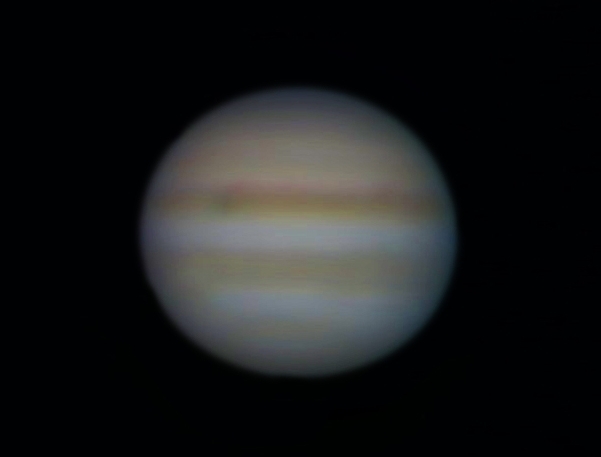
Jupiter, with a hint of Great Red Spot (lower-left) and the shadow of Io (upper-left)
After that, I put away the webcam and attached the Nikon D50 instead, still using the eyepiece-projection method, and rattled off a selection of wider-field shots of the planet with some of its moons. I had to use longer exposures to get the moons, and shorter ones to get Jupiter, so the images produced are composites. The best one of these is:
Left to right: Europa, Ganymede, Jupiter, Callisto.
Io is in transit across the face of Jupiter, but it's lost in the background.
The object in the top-right corner is a star.
After a couple of hours of this, Jupiter passed out of sight so it was time to look at something else before the skies became too light. I had a look at Winstars and figured that Neptune, a planet reluctant to appear before us, might be in shot after a short wait. I slewed the scope to point at it but it was behind some trees. No matter, it was time for another brew anyway.
Neptune's not visible to the naked eye, so I had a look for it through my trusty binoculars. I found the row of three stars that currently acts as a marker for locating the planet, and, by using averted vision, could just make out a very faint dot of light where Neptune should be. Encouraged by this, I waited until the area was in sight, and took a short series of zoomed-in long exposures of the seemingly-empty area of blackness, hoping that the results would be in focus (none of the marker stars were bright enough to show up in the viewfinder, it was hit-and-hope stuff). I had to stop soon, though, as the sky was just too light, and the morning dew was beginning to form on the optics. The session was over, and I was convinced that I had failed to capitalise on this unplanned opportunity.
I packed away and headed inside to warm up. While swilling down a hot cuppa, I had a quick look at the pics that might have included Neptune, and there it was, a small blue fuzzy ball! It needed a lot of processing to get rid of the noise and other defects caused by the optics and the atmospheric conditions, but I ended up with this:
Neptune (the tiny blue dot to the right of centre), and 2 of the 3 marker-stars.
Next time out, I'll try for a better picture. It'll be easier now that I know where to look and what camera settings to use.
After a neat bit of negotiation, I managed to blag an evening of observation away from home at the location discovered here.
The main purpose of the session was to use the webcam to grab a load of .avi data of Saturn before it gets too late in the year. OK, the seeing wasn't too good after such a warm day, but I managed to reel off over 30 minutes of data before the target sank too low into the surrounding orange glow. I'm still trying to find time to process the stuff, it takes a while to deal with over 27,000 frames of varying quality, and I'm part-way through two major tasks at the moment (on dry days I'm levelling the ground and laying turf to extend the lawn, on wet days I'm installing a new bathroom suite). When I've got something reasonable out of the Saturn data, I'll let you know.
Anyway, while the scope and webcam were chugging away, I had the D50 set up on a separate tripod taking a few long-exposure widefields. One of them was a 5-minute shot trying to get some pictures of circumpolar star-trails, it looks like I've managed to capture an Iridium flare on there too. I took a few pics of some of the more obvious constellations too, before it was time to pack away.

Circumpolar star-trails with Iridium flare
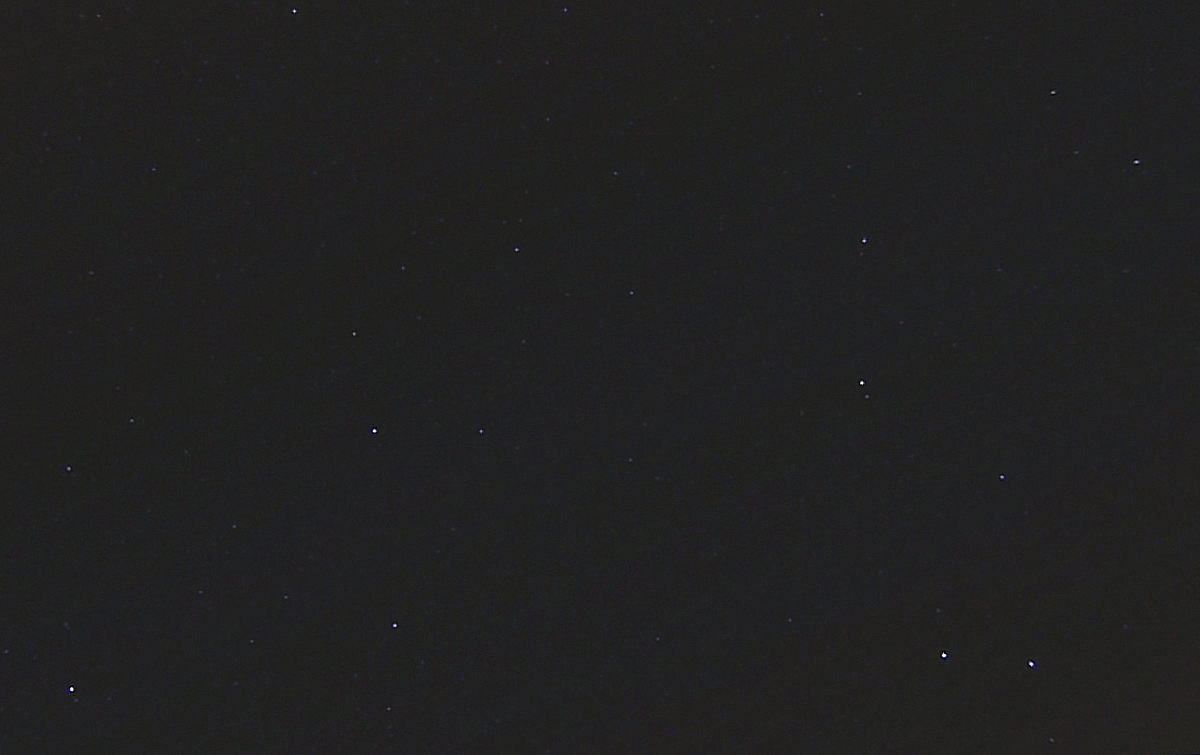
Leo with Saturn
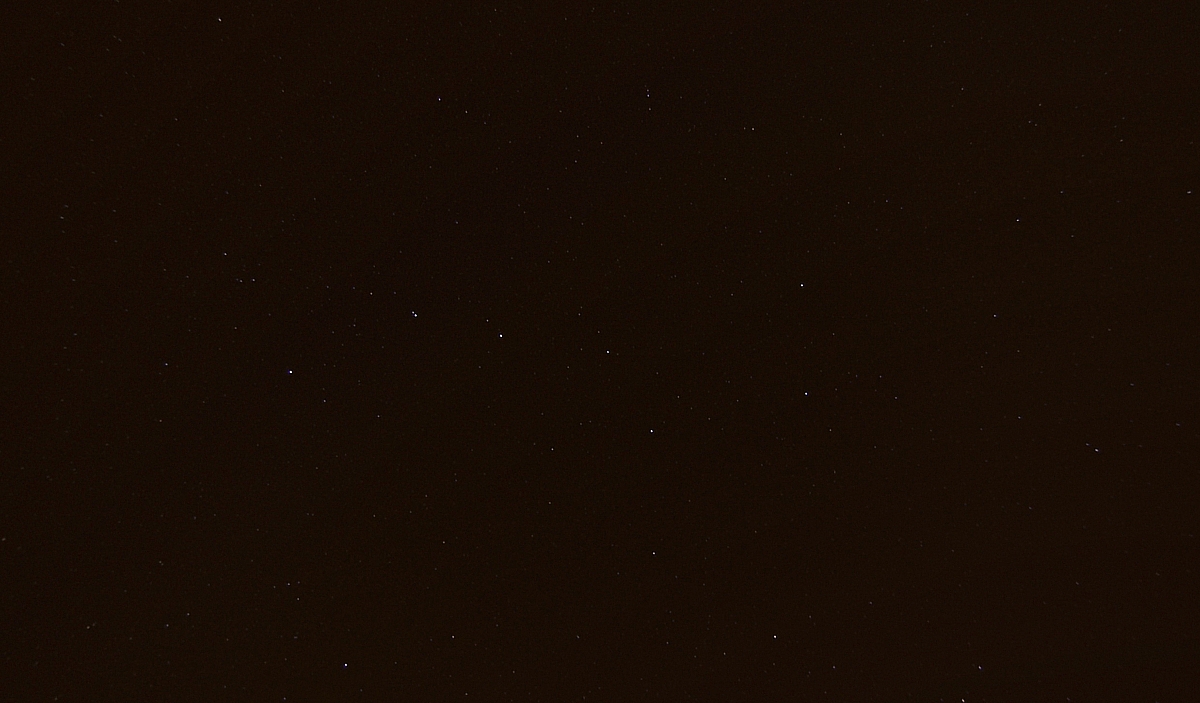
Ursa Major (The Plough), showing Mizar as a double-star

Cassiopeia rising above the glow of light-pollution
As promised, more from the latest session:
And the key:
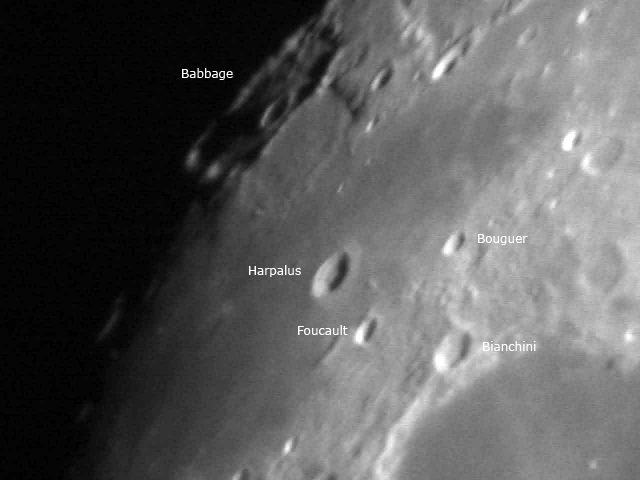
After a long run of cloudy nights a clear one was well overdue, and I was on standby, ready and waiting to get out there to try out the replacement Baader Hyperion 3.5mm eyepiece.
The skies southwards were clear, but the Moon in Virgo meant that there was a lot of glare down the scope OTA when viewing Saturn. That, coupled with the poor seeing (warm day, cold night etc. etc.) meant that imaging was always going to be a low-quality affair. Indeed, the conditions were too bad for viewing at 3.5mm (x285 mag), so I had to settle for 8mm (x125 mag) on the zoom, which is fast becoming my favourite eyepiece.
Anyway, I managed to get a fair batch of .avi files of Saturn and of parts of the Moon before condensation set in and covered the scope mirrors, terminating the observation session.
It'll take me a while to plough through the imaging data getting rid of the bad frames using VirtualDub, but for now here's a 30-second loop of the bottom edge of the Moon, as captured with the SPC900 webcam, to give you some idea of just how wobbly the view gets when the seeing is poor:
Just in case you were wondering what's what, here's the key:
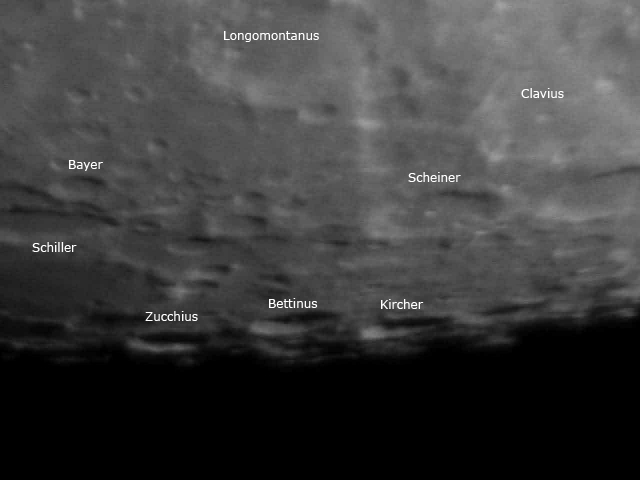
If I get any half-decent images out of the mass of video data, I'll post them tomorrow.